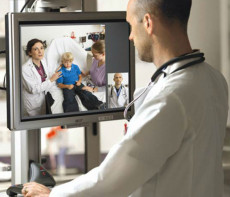Stand in the shoes of a rural North Country resident experiencing a sudden numbness in the face and left arm. Equally abrupt is a loss of vision in one eye. Luckily, you’re able to get to your local hospital quickly. As an ER physician with Adirondack Health based in Saranac Lake, Matthew Morgan, DO, would recognize your symptoms as a possible stroke. “We have a 180-minute window from the time symptoms start to administer potential life-saving medication,” said Dr. Morgan. “Unfortunately, not many facilities have a neurologist available 24/7, and the ability to diagnose a stroke or, of equal importance, confirm that it’s NOT a stroke, is critical.”
Fortunately, Adirondack Health utilizes teleneurology to effectively screen patients. “We can have a board-certified neurologist evaluating the patient within thirty minutes, from the time of consult request,” said Dr. Morgan.
With facilities in Keene, Lake Placid, Saranac Lake and Tupper Lake, Adirondack Health is the only full service health system operating within the six-million-acre Adirondack Park.
“Improving patient access to medical specialists can be a challenge in a rural region,” said Caitlyn Huntington, AHI Telemedicine Coordinator. Telemedicine, medical consultation conducted at a distance via advanced technology and video devices, has garnered support as an effective means of providing quality care. AHI supports telemedicine throughout our nine-county North Country region by serving as a resource, organizing educational opportunities, sharing grant information and coordinating applications.
“By utilizing telemedicine, access to specialists improves and travel and time considerations are also alleviated,” said Huntington.
“We’re very pleased with Adirondack Health’s teleneurology service,” said Dr. Morgan. “We see an average of 75 – 100 possible stroke patients annually in the ER and all have been evaluated within the critical 30-minute consultation window.” With the support of 20 board-certified neurologists providing consultations in New York State, “every patient is seen within the treatment window.”
How it Works
Telemedicine requires specific equipment for both the patient and the provider. “We have a mobile cart that is brought to the patient equipped with a monitor, camera, sound capabilities and a computer with a high bandwidth connection for real-time video conferencing,” explained Dr. Morgan. “The receiving physician has the capability to guide the camera to conduct their evaluation.”
During the entire encounter, patients are under the constant care of Adirondack Health’s skilled medical team who provide monitoring and support. “Despite the stressful circumstances, patients seem very comfortable interacting with the neurologist via the monitor,” noted Dr. Morgan.
A potential obstacle to adopting telemedicine is the investment in equipment. “Adirondack Health is pursuing grants to expand the program,” said Dr. Morgan. “Medical specialties that seem to lend themselves to telemedicine include dermatology, psychiatry, and rheumatology. These can be regular office visits where a patient appointment could often entail a long drive or six-month scheduling. Telemedicine significantly reduces that wait time.”
The Future of Telemedicine
“Telemedicine has the potential to expand in our region in the near future,” said Huntington. This expansion is supported by a recent announcement from the NYS Department of Health that services delivered via telehealth are eligible for reimbursement through commercial insurers and the Medicaid program. The reimbursement level for a telehealth session equates to an office visit. A patient can visit a local practitioner, and follow the standard intake procedure with a nurse taking vitals. The patient would then be connected to a provider located off-site.
The state expanded eligibility to providers beyond physicians, including mid-level providers such as nurse practitioners, social workers, and midwifes. “Imagine being a homebound or bed-bound diabetic and having the ability to log into your personal computer to check in daily with your nurse, leading to conversations about your medications and blood sugar. This kind of connection can make a tremendous difference in care,” said Dr. Morgan.
For More Information
AHI supports telemedicine in our nine-county region by connecting funding, training, and best practices to regional partners. Activities include:
- Seeking grant funding opportunities;
- Establishing telehealth user collaborative meetings;
- Serving as a resource;
- Developing a webinar series on telemedicine implementation and program planning;
- Collaborating with ACTION (Adirondack Champlain Telemedicine Information Network), a seven county consortium established to bring broadband to the Adirondacks. The group leverages connections with telecommunications providers.
To learn more about telemedicine, visit AHI Telemedicine and Adirondack Health.


